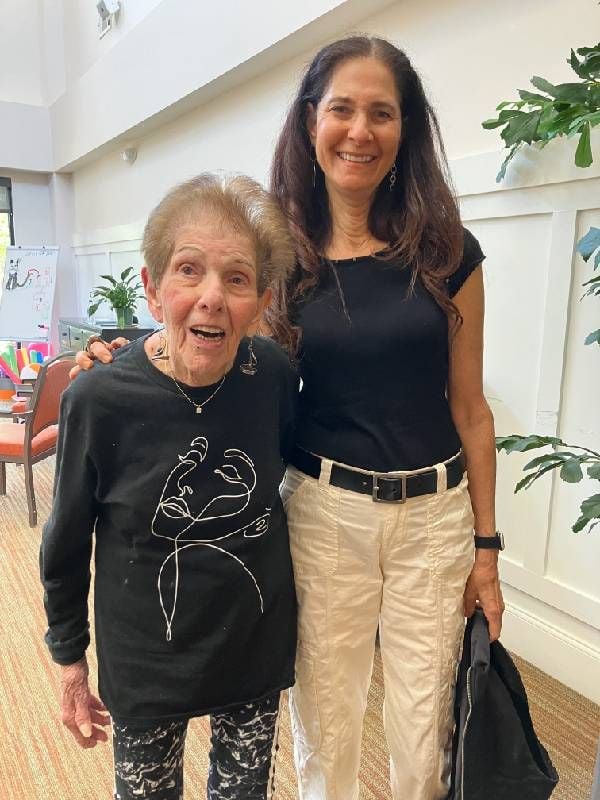Clothing Once Divided My Mom and Me — Now It Unites Us
Even though my mother pushed me to dress in a way that didn't mesh with who I was, I have been able to recognize it as her attempt at caretaking and now can do the same for her
One of my earliest memories is of getting myself dressed and ready for school one early morning without any input from my mother. I was in second grade, and as I hurriedly pulled on my dress, tights and Red Goose Mary Jane shoes, I thought about how she was going to fall all over herself praising my staggering level of maturity.

I sat down on my bed and waited, giddy for the moment she would discover me on her way to the kitchen. But there was no dramatic outpouring of praise. Instead, she glanced into my room, muttered, "Good girl," and kept walking.
By the time I was a teenager, my mother and I butted heads over what I should wear. She was a smart dresser with a flair for mixing colors, fabrics and patterns. She always wore heels, had an impressive collection of belts and scarves, and she wanted me to wear these things, too.
But the way I saw it, my body was a problem. I was chubby until seventh grade; throughout high school I dieted constantly, struggling to lose the extra ten pounds I believed were responsible for all of my woes. Throughout every incarnation of my body, I favored jeans, T-shirts, boots and sneakers.
"Oh Dana," my mother would croon, pulling a long, flowy outfit from a crowded rack at Loews department store and holding it up in front of me, "Only YOU could wear this." She meant it as a compliment: I was 5'9" while she was just 5'4", and she mourned her lack of height for how it limited the clothing styles available to her.
By continuing to push clothes on me that were well out of my style and comfort zone, I felt like my mother was refusing to see me for who I was.
Still, the comment always enraged me for the way I felt it (at best) ignored and (at worst) negated who I was. By continuing to push clothes on me that were well out of my style and comfort zone, I felt like my mother was refusing to see me for who I was. Was that early letdown — when she failed to "see" my burgeoning maturity — a harbinger of these later instances where I felt invisible?
What Are We Really Fighting About?
Without a doubt, clothing — what and how we choose to wear what we wear — is more than just a cover for the body. It's a conscious communication tool, one of the best ways we have of expressing our identity, values, interests and beliefs without speaking a word.
It's no surprise, then, that struggles in this arena arise between children, especially pre-teens and adolescents, and their parents. More often than not there is pressure in kids' social circles to look a certain way, which may not mesh with the vision a parent has for the child. Disagreements over hair and hem length, what is too baggy or too tight, and even what is weather appropriate are all too common.
But sometimes what we are struggling with is just the tip of the iceberg, or a stand-in or for the real point of contention. Gail Saltz, MD, Clinical Associate Professor of Psychiatry at the New York Presbyterian Hospital, Weill-Cornell Medical College and a psychoanalyst with the New York Psychoanalytic Institute, suggests that the mother-daughter tension that can flare around how to dress might actually arise from a mother's conscious or unconscious attempt to "teach" her daughter what she believes it "means to be feminine."
Mother-daughter tension that can flare around how to dress might actually arise from a mother's conscious or unconscious attempt to "teach" her daughter what she believes it "means to be feminine."
As adults, Saltz says, we believe we know the right way to do things, and that it's our job to pass this knowledge on. A child, however, particularly one just beginning to navigate the waters of identity, might see this "teaching" as criticism. They might not want what the parent wants for them, might have their own vision or ideas about how best to express their selfhood.
As adults, being comfortable in our clothes enhances our self-confidence; similarly, children feel most comfortable and empowered in attire of their choosing, and if the parent does not or cannot allow room for self-expression, then conflict, disempowerment and diminished confidence in the child can result.
From Clothing Wars to Food Wars
By the time I went away to college, my mother and I had been co-dieting for years. Though not significantly overweight, we were both uncomfortable with the size of our bodies, and so, while we met in struggle over what to put ON our bodies, we met in agreement over what to put IN them, which was food that was low in calories, fat and carbohydrates. Until, that is, I took it too far and became anorexic, at which time a new struggle developed between us: what I should weigh.
"Along with a genetic component, over-intrusive moms whose messaging is that the daughter look perfect" can lead to an eating disorder, says Saltz. The feeling that my mother always disapproved of the way I dressed — which I internalized to mean she disapproved of the person I was —negatively influenced the way I saw myself, until what I perceived as critical messages about my lack of attractiveness and worth were all I could hear. It would be years before I was able to remove myself from the loop of self-disparagement, and get a healthy toehold in my life.
While her misguided attempts to mold me into a taller, lither version of herself were unnuanced and ultimately detrimental, I believe they came from a place of admiration.
Navigating Forgiveness
My mother is 94 now and has Alzheimer's. But she still loves clothes, is particular about what she wears, and notices and comments (mostly positively now) on the way I look when I visit her at her assisted living residence. Because she is still interested in fashion, and because I know her style so well after all these years, nothing makes me feel closer to her than when I am out shopping and find a piece of clothing "only she could wear." It's a shared moment of delight when I give it to her.
As I've gotten older, I've been able to see my mother — and our past struggles — in a more mature and objective light. I fully believe she didn't set out to damage me or my sense of self, and I know from the stories she's told me that she struggled to shake the negative messaging she got from her own mother about her "chubby" body. I have moved from a position of youthful blame to one of tender forgiveness.
While her misguided attempts to mold me into a taller, lither version of herself were unnuanced and ultimately detrimental, I believe they came from a place of admiration, of wanting for me whatever glory her height and weight denied her.

While it isn't always easy to find a way back to a parent whose influence has been negative, there is value in it, says Saltz, if the relationship is not terribly toxic.
"Usually it requires the parent to accept responsibility for the damage…to give a robust apology. Any acknowledgement or apology from the parent that allows the child to say, 'I forgive you; I understand how [the problem] came about,' allows at least a détente, but even more so, may allow them to really connect over the previously troubled area."
In other words, it's generally up to the parent to open the apology, although if there has been mutual acting out — if both the parent and child can see that they contributed to, or exacerbated, the divide, then the adult child can act first to extend an apology.
Unfortunately, says Saltz, there are those instances where either the parent or the child are unable to find a way to forgiveness. In my case, I didn't feel that discussing old hurts would be productive, given my mother's dementia, and instead was lucky enough to find a way for us to connect that didn't require it.
Connecting Over a Past Divide
My mother loves faces: sculptural faces, earrings that are faces, flower pots with faces painted on them. A couple of weeks ago when I went to see her, I brought her a black and white T-shirt I'd ordered, on which is a line drawing of a face. She squealed when I pulled it out of the bag and showed it to her, which filled me with joy. When my brother picked her up for lunch a few days later, she was wearing the shirt.
I didn't feel that discussing old hurts would be productive, given my mother's dementia, and instead was lucky enough to find a way for us to connect that didn't require it.
"Giving a piece of clothing that delights your mother is giving delight," says Saltz. She adds that, even though my mother pushed me to dress in a way that didn't mesh with who I was, I have been able to recognize it as her attempt at caretaking; in return, engaging with her in this new, positive way around clothes is a way for me to give back, or caretake her.
"There is something reparative in it," says Saltz, "an undoing of the earlier conflict."
What an amazing place this is that we've come to, so far from the days when clothes were flashpoints and getting dressed was misery. I'm grateful to be able to see past the hurts my mother and I wore for so long, and to come to this place where what once divided us now unites us.

Read More

